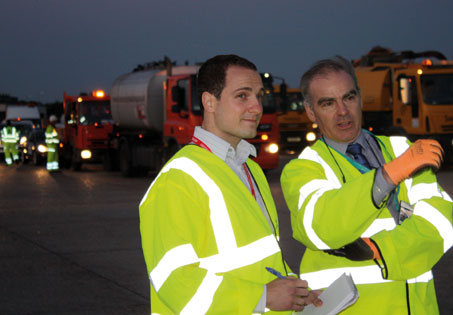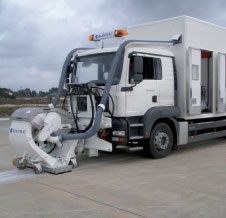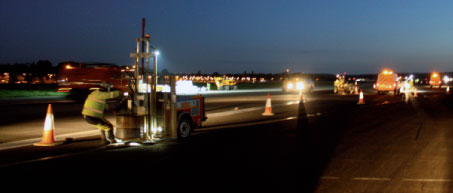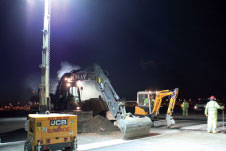
Hendry: “Getting people working together as a team is one of the critical success factors and we have to make sure we complete this work safely and without disrupting the airport.”
Over the course of the nine-month project, 400,000sqm of runway will be resurfaced using 65,000 tonnes of Marshall Asphalt, the airfield ground lighting will be upgraded with the installation of 1,900 runway and taxiway lights, and 530km of electrical cabling and 38km of ducting will be installed. The importance of the investment is highlighted by the fact that it will guarantee the safe operation of the runway for the next 12-15 years.
Construction work started on 1 March and it is being undertaken in overnight windows six days a week from 21:40-05:30. To enable the works to take place, at 21:30 the runway is closed for operations and the Northern Runway, also known as the Maintenance Runway, is brought into operation.
Blastrac’s shotblasting solution

Blastrac is a leader in the field of shotblasting, which helps to reduce the danger of slippery surfaces and remove rubber contaminants from airport runways.
The removal of rubber deposits from runways is vital to ensure operational safety and a relatively new method, known as ‘shotblasting’, is proven to offer a number of advantages when it comes to improving the braking performance of pavement surfaces.
Blastrac is a leader in the field of shotblasting, which is a cost-effective, environmentally friendly and high performance technology that helps to reduce the danger of slippery surfaces and remove rubber contaminants from airport runways.
It improves skid resistance of surfaces that have become polished with traffic or new surfaces that have a coating of bitumen binder over the aggregate particles. The improvement of runway micro texture with the Blastrac process has been repeatedly demonstrated to be extremely effective as in all cases it brings the surface micro texture back to that of the aggregate’s full ability. Shotblasting is the only technology that creates both macro and micro texture on asphalt and concrete surfaces.
The shotblasting process used by Blastrac is fully controlled, safe and environmentally efficient. It uses no water, chemicals or solvents, emits no pollutants or dust, and the removed material can be fully recycled.
Operating in over 80 countries, the Blastrac product range now has some 65 machines, from handheld products to truck mounted and fully remote controlled blasters.
“Every single part of the project has to be carried out with military precision and we work very closely with all of the contractors to make sure that it goes to plan every night,” Hendry said. “Getting people working together as a team is one of the critical success factors and we have to make sure we complete this work safely and without disrupting the airport.”
At the peak of the project, around 300 workers will be working on the runway, making use of as many as 100 vehicles. Responsibility for ensuring that the project remains on track lies with VolkerFitzpatrick, which has been employed as the principal design and build contractor, and Alistair Thompson, Director Major Projects, explained that ensuring that every member of the team is fully aware of their own role is the key to ensuring a successful delivery. “Every night, every single person out here knows what has to be done and we never do more than has been planned. This helps to ensure that we stick to the specific timeframe that has been set out and so far we have handed the runway back ahead of time every morning,” he said. “As the lead contractor, we have four primary concerns: the safety of the workforce on the runway; to hand the runway back in a completely safe condition at 05:30 every morning; to meet our programme for the project; and to stay within budget.”

At the peak of the project, around 300 workers and 100 vehicles will be working overnight on the runway.
He continued: “We’re very pleased with how the project is going so far. We’ve had a few challenges with the weather, but that’s to be expected and you have to work around that. We’re looking forward to continuing to work closely with Gatwick to successfully deliver the project on time and on budget.”
Minimising waste
As with every aspect of the ongoing £1.2 billion (€1.5 billion) Capital Investment Programme, environmental sustainability is a vital factor in the runway refurbishment. Managing waste during the construction period is especially important and when the existing runway surface is planed off, the material is recycled wherever possible on other areas of the airport. Anything that cannot be reused on the airport site is instead utilised on other local projects. This environmental focus is in keeping with the airport’s target to reuse or recycle 85% of all construction waste. Stewart Wingate, CEO, London-Gatwick, said: “Every part of the project so far has been subject to environmental impact reviews and our focus will be on continuing our efforts in that direction. Our focus will also be on how we get the maximum and most efficient usage out of the single runway, two terminals and other facilities that we already have.”
Good progress

Over the course of the nine-month project, 400,000sqm of runway will be resurfaced using 65,000 tonnes of Marshall Asphalt.
While undertaking any runway resurfacing in a live environment is testing, the London-Gatwick project comes with added pressure due to the fact that it is the world’s busiest commercial runway. “The runway refurbishment is the most important part of the investment because without the runway the airport couldn’t be operational. It is the world’s busiest commercial runway but that comes with the pressure of the project and having to keep it operational and safe,” said Hendry, who has previously overseen resurfacing projects at Glasgow, Aberdeen and Edinburgh airports.
However, in spite of the added pressure, Hendry stated that he is “happy with how everything is going” and explained that the project is very much on track in terms of the timeframe that was initially set out. “Our priority between now and the end of the project will be the continued safe operation of the airport,” he concluded.







